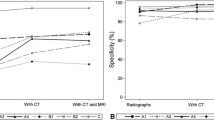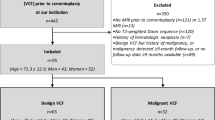Abstract
Introduction
The role of magnetic resonance imaging (MRI) has recently been enhanced in the diagnosis of thoracolumbar fractures due to its ability to examine soft tissue injury.
Material and methods
We conducted a prospective study to analyze the usefulness of MRI in fracture diagnosis and its influence on treatment decision making. Thirty-three patients were enrolled after suffering an acute traumatic thoracolumbar fracture. Osteoporotic or pathologic fractures were excluded. Fractures were initially classified using X-ray and CT scan following the AO classification. Afterward, a selective MRI protocol was performed with T1 and T2-weighted FS/STIR sequences. Subsequently, fractures were classified according to the TLICS system and reclassified following the AO system. Analysis was performed before and after MRI, focusing on: diagnostic changes, occult fractures and differences in treatment decision making.
Results
Thirty patients (15 males, 15 females) with an average age of 39.9 years were studied. Forty-one fractures were initially diagnosed using plain X-rays and CT scans, while MRI diagnosed 50 fractures and 9 vertebral contusions. MRI modified our diagnosis in 40% of our patients (discovering 18 occult injuries), the classification of fracture pattern in 24% of the fractures (mostly upgrading type A to type B patterns) and the therapeutic management in 16% of our patients.
Conclusions
MRI seems to be a useful tool in the evaluation of thoracolumbar acute fractures, as it allows a better visualization of the posterior complex integrity and of the levels involved, offering additional information compared to traditional diagnostic tools.


Similar content being viewed by others
References
Aebi M (2010) Classification of thoracolumbar fractures and dislocations. Eur Spine J 19:S2–S7
Bagley LJ (2006) Imaging of spinal trauma. Radiol Clin North Am 44:1–12
Beisse R (2010) Endoscopic surgery on the thoracolumbar junction of the spine. Eur Spine J 19:S52–S65
Dai LY, Ding WG, Wang XY, Jiang LS, Jiang SD, Xu HZ (2009) Assessment of ligamentous injury in patients with thoracolumbar burst fractures using MRI. J Trauma 66:1610–1615
James KS, Wenger KH, Schlegel JD et al (1994) Biomechanical evaluation of the stability of thoracolumbar burst fractures. Spine 19:1731–1740
Lee HM, Kim HS, Kim DJ et al (2000) Reliability of magnetic resonance imaging in detecting posterior complex injury in thoracolumbar spinal fractures. Spine 25:2079–2084
Lee JY, Vaccaro AR, Schweitzer KM et al (2007) Assessment of injury to the thoracolumbar posterior ligamentous complex in the setting of normal-appearing plain radiograph. Spine J 7:422–427
Leferink VJ, Veldhuis EF, Zimmerman KW, ten Vergert EM, ten Duis HJ (2002) Classificational problems in ligamentary distraction type vertebral fractures: 30% of all B-type fractures are initially unrecognised. Eur Spine J 11:246–250
Magerl F, Aebi M, Gertzbein SD, Harms J, Nazarian S (1994) A comprehensive classification of thoracic and lumbar injuries. Eur Spine J 3:184–201
Oner FC, Ramos LMP, Simmermacher RKJ, Kingma PTD, Diekerhof CH, Dhert WJA, Verbout AJ (2002) Classification of thoracic and lumbar spine fractures: problems of reproducibility. A study of 53 patients using CT and MRI. Eur Spine J 11:235–245
Oner FC, van Gils APG, Faber JAJ, Dhert JA, Verbout AJ (2002) Some complications of common treatment schemes of thoracolumbar spine fractures can be predicted with magnetic resonance imaging. Prospective study of 53 patients with 71 fractures. Spine 27:629–636
Oner FC, van der Rijt R, Ramos LMP et al (1999) Correlation of MR images of disc injuries with anatomic sections in experimental thoracolumbar spine fractures. Eur Spine J 8:194–198
Parizel PM, van der Zijden T, Gaudino S, Spaepen M, Voormolen MHJ, Venstermans C, De Belder F, van den Hauwe L, Van Goethem J (2010) Trauma of the spine and spinal cord: imaging strategies. Eur Spine J 19:S8–S17
Ponnappan R, Lee YL (2009) Thoracolumbar trauma. In: JS F (ed) Orthopaedic Knowledge Update 9, Spine (AAOS), Spanish edition. Medical Trends SL, Barcelona, pp 49–61
Terk MR, Hume-Neal M, Fraipont M et al (1997) Injury of the posterior ligament complex in patients with acute spinal trauma: evaluation by MR imaging. Am J Roentgenol 168:1481–1486
Vaccaro AR, Lee JY, Schweitzer KM et al (2006) Assessment of injury to the posterior ligamentous complex in thoracolumbar spine trauma. Spine J 6:524–528
Vaccaro AR, Rihn JA, Saravanja D et al (2009) Injury of the posterior ligamentous complex of the thoracolumbar spine a prospective evaluation of the diagnostic accuracy of magnetic resonance imaging. Spine 34:E841–E847
Vaccaro AR, Lehman RA Jr, Hurlbert RJ et al (2005) A new classification of thoracolumbar injuries: the importance of injury morphology, the integrity of the posterior ligamentous complex, and neurologic status. Spine 30:2325–2333
Vaccaro AR, Zeiller SC, Hurlbert RJ et al (2005) The Thoracolumbar Injury Severity Score: a proposed treatment algorithm. J Spinal Disord Tech 18:209–215
Valentini MC, Busch R, Ferraris MM, Venturi F (2006) The role of imaging in the choice of correct treatment of unstable thoraco-lumbar fractures. Eur J Radiol 59:331–335
Williams RL, Hardman JA, Lyons K (1998) MR imaging of suspected acute spinal instability. Injury 29:109–113
Conflict of interest
None.
Author information
Authors and Affiliations
Corresponding author
Rights and permissions
About this article
Cite this article
Pizones, J., Izquierdo, E., Álvarez, P. et al. Impact of magnetic resonance imaging on decision making for thoracolumbar traumatic fracture diagnosis and treatment. Eur Spine J 20 (Suppl 3), 390 (2011). https://doi.org/10.1007/s00586-011-1913-4
Received:
Accepted:
Published:
DOI: https://doi.org/10.1007/s00586-011-1913-4




